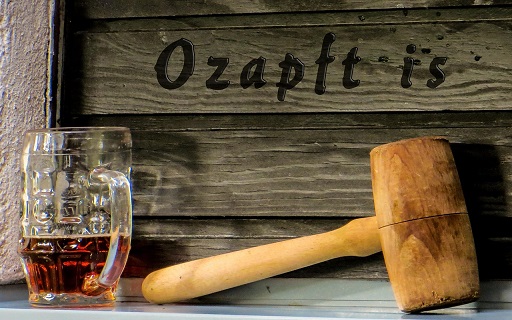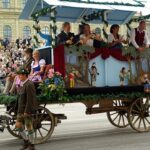
Before it became synonymous with beer steins, brass bands, and Bavarian revelry, Oktoberfest was a simple celebration of love. The roots of this world-famous folk festival lie not in breweries or tourist brochures, but in a royal wedding over 200 years ago. Today, Oktoberfest is the largest beer festival on the planet, drawing over six million visitors annually. But how did it begin, and how did it become the global cultural phenomenon we know today?
This is the story of Oktoberfest – from its noble beginnings to its beer-fueled legacy.
➡️ Related: The Oktoberfest Parade: Marching Through Bavarian History
1810: A Royal Wedding That Started It All
The very first Oktoberfest took place on October 12, 1810, to celebrate the marriage of Crown Prince Ludwig of Bavaria (later King Ludwig I) and Princess Therese of Saxony-Hildburghausen. Citizens of Munich were invited to join in a public celebration held on the fields outside the city gates.
The event concluded with a grand horse race, and the fields where it all took place were later named Theresienwiese in honor of the bride. That name remains today – although locals affectionately call it “die Wiesn.”
Because the celebration was so well received, the decision was made to repeat it the following year. Thus, Oktoberfest was born.
Early Oktoberfests: Horses, Agriculture, and Civic Pride
The festival in its earliest form was more agricultural fair than beer festival. While beer and food were present from the start, the main attraction for decades was the horse racing and an annual agricultural show (still held every four years).
In these early decades, Oktoberfest was:
- A showcase for Bavarian culture and farming
- A patriotic display of unity and tradition
- An opportunity for Munich’s guilds and shooting clubs to parade
The growing popularity of beer gardens in the mid-19th century gradually gave the festival a more festive character. The beer flowed more freely – and the party atmosphere started to build.
The Birth of the Beer Tents and Breweries’ Role
By the 1890s, the modern Oktoberfest format began to take shape. Munich’s major breweries – including Augustiner, Spaten, Hofbräu, Löwenbräu, Paulaner, and Hacker-Pschorr – set up beer tents and halls, offering visitors a place to sit, drink, and enjoy music.
Key developments included:
- Electrification: By the 1880s, electric lighting extended the festivities into the night
- Carnival rides and amusements: Carousels and swings arrived
- Music and entertainment: Oompah bands became standard fare
As the 20th century dawned, Oktoberfest was already well on its way to becoming a full-blown beer festival – but not without interruptions.
Interruptions and Resilience: War, Disease, and Revival
Like many major events in history, Oktoberfest was interrupted multiple times:
- Napoleonic wars: No festivals from 1813–1815
- Cholera outbreaks: 1854 and 1873
- World War I: 1914–1918
- Hyperinflation: Cancelled in the early 1920s
- World War II: 1939–1945
During some of these interruptions, smaller festivals or Autumn Celebrations were held, but Oktoberfest proper always returned.
After World War II, Oktoberfest was revived in 1949 and resumed its full scale. By the 1960s and 70s, it had cemented its reputation as a major international event.
Why It’s Held Mostly in September
If Oktoberfest began in October, why does most of it now happen in September?
The answer is weather. September in Munich offers more pleasant temperatures and longer daylight hours. The modern festival begins in mid-September and ends on the first Sunday in October, with a few exceptions if the holiday of German Unity extends the final weekend.
Today’s Oktoberfest: Scale and Spectacle
Modern Oktoberfest is a feat of logistics and tradition:
- 6 million+ visitors annually
- Over 7 million liters of beer consumed
- 14 large beer tents, some seating over 10,000 people
- 21 smaller tents with regional specialties
- Carnival rides, parades, concerts, and family days
Despite its massive scale, Oktoberfest still retains its traditional core. Each year begins with:
- A costume parade featuring traditional Bavarian Tracht
- The opening keg tapping by the Mayor of Munich
- The cry of “O’zapft is!” (“It’s tapped!”)
➡️ Also read: Oompah Bands and Beer Tents: The Soundtrack of Oktoberfest
Cultural Traditions That Still Matter
While beer is the headliner, Oktoberfest is also a celebration of:
- Bavarian clothing: Dirndls, Lederhosen, and regional costume groups
- Folk traditions: Parades, shooting clubs, and flag-wavers
- Cuisine: Roast chicken, sausages, pretzels, Obatzda, and more
- Family values: Tuesdays are designated family-friendly days
Locals often visit during the week, and many families return year after year – proof that the festival is still deeply tied to community.
Exporting Oktoberfest: A Global Phenomenon
Oktoberfest celebrations now take place around the world, from Cincinnati to Tokyo, Kitchener-Waterloo to Brisbane. While no replica can match the original in scale or atmosphere, these international versions honor the spirit of Bavarian Gemütlichkeit.
They include:
- German-style beers and food
- Local oompah bands
- Traditional dress and toasts
Some have become sizable festivals in their own right, attracting hundreds of thousands.
Oktoberfest in the Modern Age: Balancing Tradition and Tourism
In recent years, Oktoberfest has faced the challenge of preserving authenticity while welcoming a growing international audience. Measures to maintain its cultural roots include:
- Music quotas favoring traditional over pop
- Limits on capacity and ticketed reservations
- Promoting weekday visits for locals
At the same time, the festival has embraced modern infrastructure:
- Advanced security and police presence
- Digital reservations for tents
- Sustainability efforts (waste reduction, recycling, local sourcing)
The result is a rare event that blends old-world charm with global appeal.
Oktoberfest’s Deeper Meaning
Beyond the beer, Oktoberfest is a celebration of Bavarian identity – its customs, values, and hospitality. It embodies:
- Tradition: A living link to centuries past
- Community: Bringing together neighbors and strangers
- Joy: A break from daily life to eat, drink, sing, and connect
At a time when many cultural expressions fade, Oktoberfest continues to thrive. Not by clinging rigidly to the past, but by evolving while staying true to its heart.
What began as a wedding celebration in 1810 has become a defining expression of German folk culture. Today’s Oktoberfest may feature giant beer tents and roller coasters, but its essence remains remarkably close to its roots – hospitality, celebration, and community.
Whether you attend in Munich or abroad, raise your Maß and toast to the history behind the festival. Because Oktoberfest isn’t just about beer – it’s about belonging to a tradition bigger than yourself.
➡️ Explore Oktoberfest articles:







